Asian Economic Integration Report 2023This report shows how smart trade and investment policies, and regulatory cooperation in the Asia and Pacific region can help economies tackle climate change, recover from the pandemic, and support resilient and sustainable development. Analyzing topics including global value chains, investment, the movement of people, and regional cooperation initiatives, it outlines the economic and environmental challenges the region currently faces. It explores how trade and investment policies can support climate action and highlights why a joined-up approach is essential to help deepen the digital economy, strengthen supply chains and foster greener businesses, markets, and trade. Author: Asian Development Bank Year: 2023 Download Tags: SASEC, Infrastructure, ADB, Connectivity, Climate Change, Global Value Chains, Trade Review of Maritime Transport 2022Ships carry over 80% of the volume of global trade. In South Asia, intraregional shipping connections increased as India improved its shipping connections to Pakistan, Sri Lanka, People's Republic of China, the Republic of Korea, Malaysia, Saudi Arabia, Singapore, and the United Arab Emirates. The most connected port in South Asia is the Colombo port in Sri Lanka; the Colombo port ranked the 24th best port in the world in 2021. Author: United Nations Conference on Trade and Development Year: 2022 Download Tags: India, Sri Lanka, Transport, Trade, Global Value Chains World Investment Report 2018In India, foreign direct investment (FDI) inflows dropped from $44 billion in 2016 to $40 billion in 2017. Across South Asia, FDI inflows are predicted to stagnate or decline marginally in 2018. The global trend in FDI flows demonstrates the need for open, transparent, and non-discriminatory investment policies to maintain an environment conducive for investment. New types of industrial policies are emerging to respond to opportunities and challenges brought about by a new industrial revolution. This report examines investment policy tools available in the new environment. Author: United Nations Conference on Trade and Development Year: 2018 Download Tags: Connectivity, FDI, Global Value Chains, India, Investment, Policy, Sustainable Development Goals, South Asia, UNCTAD Services and Global Value Chains: The Asia-Pacific Reality, Studies in Trade, Investment and Innovation 89This book reviews issues concerning the roles of services in global value chains. It presents a framework for assessing links among different services and between services and the manufacturing sector. The book explains the contribution of services to global value chains in the Asia-Pacific region and to the world and also draws lessons with which countries could understand the importance of services and participation in global value chains to achieving sustainable development. Author: Witada Anukoonwattaka, Mia Mikic, Yuhua Zhang Year: 2017 Download Tags: ASEAN, Asia-Pacific, Energy, Global Value Chains, India, Nepal, Regional Cooperation, Sri Lanka, Sustainable Development, Sustainable Development Goals, Trade Facilitation, UNESCAP SME Guide to Value ChainsThis is a guide for small and medium enterprises (SMEs), providing insights on entering international value chains and building business relationships. It discusses compliance with standards and regulations, contractual relationships, production and performance management, and strategies for diversification. It features success stories of small companies from India and other countries, illustrating how these companies became regional or global leaders. Author: International Trade Centre Year: 2017 Download Tags: Global Value Chains, India, Small and Medium Enterprise World Trade Report 2017: Trade, Technology, and JobsEconomic growth over the last 25 years has been accompanied by unprecedented economic change. Over the past two decades, many countries have experienced significant transformations in the sectoral and occupational structure of employment. This report examines how technology and trade affect employment and wages and analyzes the challenges for workers and firms in adjusting to changes in labor markets. It looks at how governments could increase the positive impact of open trade and technological trade in South Asia and around the world. Author: World Trade Organization Year: 2017 Download Tags: Trade, ICT, Employment, Global Value Chains, South Asia Myanmar’s Integration with the WorldMyanmar only recently began participating in global trade and investment. It has large untapped potential for trade and investment in agriculture and forest-based industries, and services, such as tourism and information technology. This book examines Myanmar’s access to the global market and examines the implication of Myanmar’s democratic transition, the progress of Myanmar’s industry and infrastructure, its international linkages, and options for increased integration in regional economic groups. The book also analyzes how Myanmar could exploit global value chains. Author: Prabir De and Ajitava Raychaudhuri, editors Year: 2017 Download Tags: Agriculture, Global Value Chains, Infrastructure, Investment, ICT, Myanmar, Regional Integration, Trade World Investment Report 2017This report presents foreign direct investment (FDI) trends and prospects at global, regional and national levels. FDI flows to developing Asia contracted by 15% to $443 billion in 2016. This decline was relatively widespread, except in South Asia, where several countries including Bangladesh and Nepal are expected to receive more FDI in the coming years. The report investigates the internationalization patterns of digital multinational enterprises, as well as the effect of digitalization on global companies across all industries. It provides insights to policymakers on how the digital economy impacts investment policies and how investment policy can support digital development, with a view toward achieving the SDGs. Author: United Nations Conference on Trade and Development Year: 2017 Download Tags: FDI, Global Value Chains, Investment, Policy, South Asia, UNCTAD, Bangladesh, India, Nepal 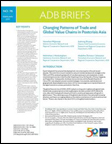 Changing Patterns of Trade and Global Value Chains in Postcrisis AsiaThis Asian Development Bank brief examines how patterns of trade and global value chains (GVCs) in developing Asia have changed since the global financial crisis. The paper reports that export slowdown in the region was caused by a combination of weak import demand for Asian goods in advanced economy markets, structural transformation and reduced import demand in the People’s Republic of China, and possible impact of increasing non-tariff measures. According to this paper, it further states that much of the weak import demand is likely
to be temporary — developing Asia gained a 1.5% increase in exports in 2016, after a 0.8% decline in 2015. Among South Asian economies, India and Sri Lanka are expected to have better export volume growth in 2016. Author: Ganeshan Wignaraja, Juzhong Zhuang, Mahinthan J. Mariasingham, and Madeline Dumaua-Cabauatan Year: 2017 Download Tags: Global Value Chains, Import, Export, India, Sri Lanka, Non-Tariff Measures, Trade Facilitation Accumulating Trade Costs and Competitiveness in Global Value ChainsThis paper examines the implications of trade costs, including applied tariffs, transportation and insurance costs, on competitiveness at industry, national and global levels, and identifies where trade facilitation investment would have the highest social returns from the perspective of global value chains (GVCs). With trade costs amplified along GVCs, profitability of individual business operations are affected by incurred transaction expenses. The authors conclude that direct benefits of trade facilitation will be higher for countries that are not yet well integrated into international trade, but key traders who are at the core of GVCs also stand to gain much. Author: Antonia Diakantoni, Hubert Escaith, Michael Roberts and Thomas Verbeet Year: 2017 Download Tags: Trade, Tariff, Transport, Trade Facilitation, Global Value Chains Trade Facilitation and Global Value Chains: Opportunities for Sustainable DevelopmentThis paper analyzes the relationship between global value chains (GVCs) and trade facilitation, and its contribution to sustainable development outcomes on low-income and least developed countries (LICs and LDCs). A key insight of the paper concludes that it is not fundamentally GVCs that drive the sustainable development implications of improved trade facilitation, but the resulting extension and intensification of economic activity. It underlines the importance of putting in place domestic regulatory infrastructure that considers the appropriate economic, social, and environmental dimensions to ensure that GVCs remain consistent with the global commitment to sustainable development, while expanding economic opportunities of LICs and LDCs. Author: Ben Shepherd Year: 2016 Download Tags: Trade Facilitation, Trade, Global Value Chains, Sustainability, Sustainable Development, Least Developed Countries, LDC SME Competitiveness Outlook: Meeting the Standard for TradeStandards and regulations for goods and services are important to international trade and value chains. They ensure consumer protection, determine compatibility, and promote environmental sustainability. This SME Competitiveness Outlook focuses on helping small and medium-sized enterprises (SME) make the most of standards and regulations to increase their competitiveness. Findings include strategies for SME managers on selecting and implementing standards and regulations, and an action plan for policymakers and trade and investment support institutions involved in aiding SMEs compete in markets where standards and regulations matter. Author: International Trade Centre Year: 2016 Download Tags: Trade, Small and Medium Enterprises, Bangladesh, India, Nepal, Sri Lanka, WTO, Global Value Chains World Trade Report: Levelling the Trading Field for SMEsParticipation in international trade, once exclusive, can progressively become more inclusive. But while new opportunities are opening up for small to medium-sized enterprises (SMEs), old barriers to international trade remain. This report highlights national and international policy actions that would enhance the ability of SMEs to participate in world markets more effectively. It says that for open trade and global integration to fully benefit everyone, it is crucial to ensure that all firms—not just large corporations—can succeed in today’s global marketplace. Author: World Trade Organization Year: 2016 Download Tags: Trade, WTO, Small and Medium Enterprise, Global Value Chains Trade Costs and Inclusive Growth: Case Studies Presented by WTO Chair-holdersThese contributions from participants of the World Trade Organization (WTO) Chairs Programme—which supports trade-related activities by academic institutions in developing countries—offer insightful research on opportunities that open up for developing countries when trade costs are reduced. Analyzing the potential impact of the WTO Trade Facilitation Agreement implementation in various developing regions of the world, this publication offers detailed country-level analysis on benefits of trade facilitation, including export diversification, greater global value chain participation, insertion of SMEs into international trade, the attraction of more foreign direct investments, and better governance. Author: Robert Teh, Maarten Smeets, Mustapha Sadni Jallab and Fatima Chaudhri, editors Year: 2016 Download Tags: Trade Facilitation, Global Value Chains, Small and medium enterprises, FDI, Governance, WTO 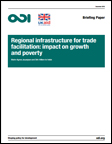 Regional Infrastructure for Trade Facilitation: Impact on Growth and Poverty Reduction - Policy SummaryThis research aims to provide evidence on the effects of regional infrastructure and associated trade cost reduction on growth and poverty reduction of economic actors, including households and firms, around the border. Data shows that investment in regional integration for trade facilitation (RITF) promotes economic activity, supports activity of informal traders, and facilitates integration into global value chains and international production networks. The report highlights that new hard infrastructure benefits economic actors more when complementary regulations that allow for efficient trade logistic services are also put in place. It recommends that policymakers account for the impact of RITF on reducing constraints to connectivity in their evaluations and policy decisions. Author: Marie-Agnes Jouanjean and Dirk Willem te Velde Year: 2015 Download Tags: Trade Facilitation, Global Value Chains, Poverty Reduction Trade in Value Added: Concepts, Estimation and AnalysisThis Asia-Pacific Research and Training Network on Trade working paper aims to explain the concept of Trade in Value Added (TiVA), which could properly measure exports of an economy. It discusses how TiVA is measured and how it can help in a more comprehensive understanding of trade flows. It also explains global value chains and reviews current initiatives in constructing regional and international input-output tables, and estimates of TiVA involving Asia-Pacific economies. Author: Marko Javorsek and Ignacio Camacho Year: 2015 Download Tags: Asia-Pacific, Global Value Chains, Trade Outward FDI by Indian Manufacturing MNEs: Impacts and Implications This Asia-Pacific Research and Training Network on Trade Working Paper investigates the home country effects of outward foreign direct investment (OFDI) on domestic activity of Indian multinational enterprises (MNEs). The empirical evidence suggests that OFDI by Indian MNEs has a positive impact on export intensity and research and development. In order to derive desired complementary benefits of OFDI by manufacturing firms, policies may be directed to enhance the country’s international supply chain connectivity for greater participation in global value chain and production network. Author: Khanindra Ch. Das Year: 2015 Download Tags: India, FDI, Global Value Chains, Trade, Export, Development, Manufacturing, UNESCAP 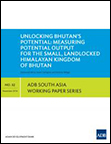 Unlocking Bhutan’s Potential: Measuring Potential Output for the Small, Landlocked Himalayan Kingdom of Bhutan The hydropower sector has driven Bhutan's economic growth in the past two decades with growth rates averaging 7.9%. Yet, the economy has not been invulnerable to market fluctuations and external shocks. This ADB South Asia Working Paper analyzes how Bhutan can create sustainable and inclusive growth, alongside the continuous expansion of its hydropower industry. It examines how certain policies can impact Bhutan's potential growth over 2013–2030. Results show that higher investment in education, health, and efforts to diversify its economic base—including enhancement of new industries with linkages to regional and global value chains—can further drive economic growth and improve the country's living standards. Author: Sabyasachi Mitra, Sarah Carrington, and Anthony Baluga Year: 2014 Download Tags: Bhutan, Energy, Economics, Hydropower, ADB, South Asia, Sustainability, Global Value Chains, Economic Growth 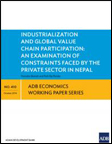 Industrialization and Global Value Chain Participation: An Examination of Constraints Faced by the Private Sector in NepalThis paper examines the constraints behind and beyond Nepal's borders that hinder its full participation in global value chains (GVC). Basing the analysis on recent and relevant publications, key economic data, and interviews with policymakers and stakeholders, the authors explain how weak and uncertain industrial policy has led to de-industrialization. They also looked at the effects of inadequate infrastructure, energy shortage, and inefficient transit. Failures in coordination, shallow regional integration and non-tariff barriers also bar further growth of Nepal's industrial development and GVC participation. The authors recommend necessary domestic reforms for behind-the-border constraints, and subregional partnerships—facilitated through the South Asia Subregional Economic Cooperation program—for beyond-the-border challenges. Author: Yurendra Basnett and Posh Raj Pandey Year: 2014 Download Tags: Infrastructure, Private Sector, Nepal, Global Value Chains, Industrialization, Infrastructure, Energy, Transport, Regional Integration, SASEC World Trade Report 2014 – Trade and Development: Recent Trends and the Role of the WTOThis annual publication highlights the relationship between trade and development, including changes since the start of the millennium. It identifies four key trends that altered the way trade affects development outcomes – accelerated economic growth in developing countries, expansion of global value chains, increase in agricultural and natural resource prices, and global nature of macroeconomic shocks. This report also explores how these trends have reshaped the role of trade in facilitating development and how recent development gains allow developing countries to adapt and mitigate risks. Author: World Trade Organization Year: 2014 Download Tags: WTO, Global Value Chains, Trade, Economic Growth, Agriculture, Trade Facilitation, Development, Bangladesh, Bhutan, India, Maldives, Nepal, South Asia, Sri Lanka Asian Development Outlook 2014 Update: Asia in Global Value ChainsAs developing Asia continues along a stable growth path, India maintains a 5.5% growth forecast for 2014 and shows promise of a turnaround. Reforms are envisioned for 2015, including a forecast 0.3% upgrade to 6.3%. Bhutan recorded the largest current account deficit as a percentage of GDP, due to imports used in construction of several large hydropower projects that will expand its energy export capacity to India. Meanwhile, South Asia is expected to perform with greater momentum in 2015, with a growth forecast upgrade to 6.1% from 5.8%. Most of the improvements in the subregion are from India’s deficit and Bangladesh’s current account. Nepal also shows improved outlook for 2015. Author: Asian Development Bank Year: 2014 Download Tags: South Asia, Global Value Chains, India, Economics, Trade 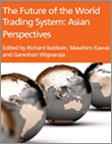 The Future of the World Trading System: Asian PerspectivesAccording to WTO Director-General Pascal Lamy, the problems facing Asian regionalism are a scaled-down version of the problems facing the world. Thus, solutions that address Asia’s noodle bowl would most likely work at the global level. This concise collection of short chapters is based on longer papers presented at the Geneva Conference on 11-12 March 2013, organized by the Asian Development Bank Institute and Centre for Trade and Economic Integration at the Graduate Institute of International and Development Studies, in collaboration with WTO. The chapters are written by leading Asian and international trade experts on key changes taking place in the world trading system and its policy implications for Asia. Author: Richard E. Baldwin, Masahiro Kawai, and Ganeshan Wignaraja, eds. Year: 2013 Download Tags: Regional Integration, Trade Policy, Trade, Global Value Chains, Global Production Network, Regional Trade, Trade Facilitation, India The ASEAN Economic Community: A Work in ProgressThis publication explores the barriers and impediments to the realization of an ASEAN Economic Community (AEC), and to what extent its self-imposed deadline of 2015 for achievement of an AEC is more of a milestone of progress than a firm target. It examines whether the AEC is achievable, the obstacles faced in achieving it, and the measures required to help it become a reality. Author: Asian Development Bank Year: 2013 Download Tags: Regional Cooperation, Regional Integration, Trade Policy, ASEAN, Economic Integration, Regional Cooperation, ADB, Regional Integration, Services, Global Value Chains, Non-Tariff Measures, Asia-Pacific Trade Agreement, India, Trade Facilitation Aid for Trade: An Investment Benefit Road Map for South AsiaAid for Trade (AfT) came to prominence just over a decade ago at the launch of the
World Trade Organization's Doha Round. With its focus on helping least developed
countries and economies escape the poverty trap, it aims to strengthen their
capabilities to meet market demand and to reduce supply-side constraints such as a lack of
trade infrastructure. Author: Asian Development Bank Year: 2013 Download Tags: Trade Policy, Poverty Reduction, Infrastructure, India, Bangladesh, Bhutan, Maldives, Sri Lanka, Nepal, Trade Facilitation, Transport, Global Value Chains, Exports |




